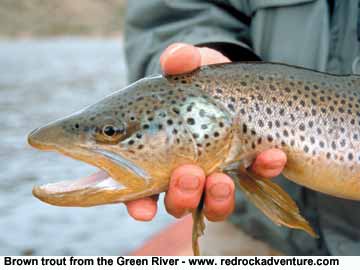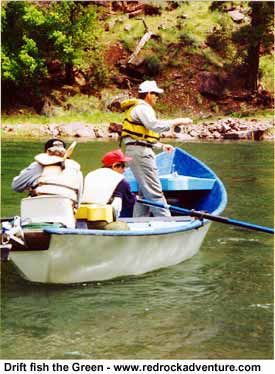
Spring Fishing on the Green
 By
Jim Brearton
By
Jim Brearton
"The Green's getting hammered." "You can't find a place to cast a fly anymore." "On weekends the place is a zoo."
I've heard enough of those reports the past few years that I approach my annual March trip to the Green with some trepidation. But on one memorial trip stormy weather and a Monday arrival must have prevented the crowds because I found a very casual Little Hole parking area, with only a few cars and drift boat trailers.
I was meeting 3 or 4 other fisherman the next day, so I set off trying to find out what was working and where to fish. As I surveyed fishermen to glean information I heard a litany of tough fishing comments. Nobody seemed to be getting into fish with any consistency. Maybe they'd been "hammered" so hard Saturday and Sunday that they weren't feeding, but I saw a few fish working the surface.
I tried the usual patterns: scuds, cranefly larvae, nymphs and Adams but I didn't touch a fish all afternoon. I saw very little spawning activity, if any, while hiking downstream from Little Hole a mile or so. I fished all the promising water but with no success. I figured I was in big trouble as a guide for my friends the next day.
 Maybe
the river was getting over fished and was deteriorating, but then it was
still March and one can expect the river to be unpredictable during early
spring. As I returned to my van I noticed a little back eddy full of fish
just a hundred yards from the parking lot. Where just a few fish had been
working earlier that day, scores of fish seemed to be in a real feeding
frenzy. Their head and tail rise indicated an emerger was their choice.
Midges were in the air so I put on a Griffiths gnat, knelt at the shoreline
to avoid detection and cast. A little raise of my rod tip to cause the
fly to ascend towards the surface and I got a strike. For the next few
minutes, until dark, I had action on almost every cast.
Maybe
the river was getting over fished and was deteriorating, but then it was
still March and one can expect the river to be unpredictable during early
spring. As I returned to my van I noticed a little back eddy full of fish
just a hundred yards from the parking lot. Where just a few fish had been
working earlier that day, scores of fish seemed to be in a real feeding
frenzy. Their head and tail rise indicated an emerger was their choice.
Midges were in the air so I put on a Griffiths gnat, knelt at the shoreline
to avoid detection and cast. A little raise of my rod tip to cause the
fly to ascend towards the surface and I got a strike. For the next few
minutes, until dark, I had action on almost every cast.
The next morning, just after sunrise, I returned to the same spot, still a little confused about what the previous day had taught me. The water level was the same so I assumed the fish were still there even if they weren't rising near the surface.
As I was wondering what to rig up my first partner arrived. Mark had come down from Cody, Wyoming, to see what real fishing was like. After I related my success and failure story from the previous day and even though he usually fished further upstream, we decided to fish right there at the parking lot eddy.
My Griffiths gnat didn't produce but Mark immediately got into fish, including a real nice brown, with an amber scud. I switched to a pinkish-orange scud and in a few minutes had a nice 18-inch rainbow.
I needed to draw some conclusions from all this. The fish of the previous day were definitely onto midges being washed into the back eddies and felt secure taking these microsized patterns even after the weekend crowds put them down. But why would they so eagerly hit our scud patterns after just a day's respite?
The only conclusion I could draw was that due to the sheer numbers of fish, the angling pressure doesn't affect their feeding habits. Because they are so opportunistic they will take whatever is available. If a bug is there in great numbers, out of the main current flow, they'll take it. One didn't need to hike to the less fished areas to take fish. They were ready and willing to take the most "opportune" food right at the parking lot.
The midges wouldn't work into the eddies until later in the afternoon so now they were feeding off the bottom. Scuds worked great but I still was yet to score with larger nymphs or cranefly larvae patterns. They were definitely selecting scuds this morning. Fishing continued good but our other two friends driving in from Provo hadn't seen us and had evidently gone upstream since we were just out of sight of the parking lot.
We found Patrick and Craig a mile above the island upstream from Little Hole. During the hike up we noticed a baetis hatch underway and soon fish were working the back eddies for the duns, lined up like a flotilla of sailing ships.
I put on a sparkle dun in baetis color and size and immediately had a fish porpoise for my fly. I missed that one. By now Mark had hooked a couple on his baetis pattern in the eddy just above me. I finally got my fly drag free to a fish I had targeted and he took it on the first pass. It appeared to be a nice cutt but he pulled free after a couple of runs.
By now most all the fish were down but still in sight so I went to a pheasant tail nymph. Craig went up on the bank and directed my casts to the fish. Mark had also switched to a pheasant tail and picked up another nice cutt just under the surface. He now had hooked a Snake River cutt, a Colorado cutt and a brown, plus numerous rainbows. A brookie would fill his "grand slam," but we didn't see any that day. I worked my nymph over several fish but had no takes. They seemed to be right on the bottom and I wasn't getting deep enough. I raised my strike indicator and on my first cast hit what I thought was a rock but Craig saw a fish flash. I inspected my fly and the point had broken off. I replaced the fly and in a few minutes had on a real heavy fish. My 5X tippet was strained to its limits keeping the fish out of heavy currents but after three wondrous leaps he soon came to the net. It was a 22 inch male bow with the biggest hook jaw and spotting I'd ever seen. He had wonderful color and spots all the way up his jaw.
The baetis had become the preferred food of these fish. The hatch was incredible. I'd never seen so many mayflies in March. The fish hit duns, emergers and nymphs during the hatch. The sparkle dun I used has a sparkle yarn tail that simulates the emerger leaving the shuck. Fish took it over duns that were everywhere on the water. Evidently the emerging mayfly is an easier target than the dun and fish take it immediately in a deliberate porpoising rise. I recommend this technique or the use of spinners when the water is covered with duns.
I picked up one more 19-to 20-inch fish on a scud after the hatch ended. This had been my best day for big fish on the Green, ever. All our fish were 15 inches or better, which is good and bad. Where were all the small planted or spawned fish? Numbers of fish per mile will diminish if the fish population isn’t being replenished. We hooked mostly rainbows but caught all species except brooks.
That night back at the parking lot eddy, we mused over the future of this fishery. The water level had gone up dramatically around 5 p.m. and the fishing was over for a while. The water looked like "spinach soup." It was a big increase and evidently the river hadn't flowed that high for quite awhile. Fluctuating water flows are one of the major challenges facing fishermen on the Green, but most tailwater fisheries fight that battle.
Increasing pressure from anglers could produce a major threat if fishermen don't develop better habits. We noticed several cans and other trash floating downstream, apparently from parties floating the river. The floating debris came from much further upstream than any waders had hiked.
We have to avoid practices such as the San Juan shuffle and over-playing fish. Everyone that fishes the river should learn to properly release fish so there are as few hooking mortalities as possible.
I consider this river to be a world-class fishery. Where else can one catch more than one 20 inch fish in one day, with large fish potential in five different species, fishing all types of water from riffles to runs to pools, on the surface or with most subsurface patterns, with prolific hatches of all major insects. What other river is able to support heavy activity due to unmatched numbers of fish per mile with unmatched growth rates. Where else can one can float or wade fish with great accessibility in an area just remote enough to provide a wilderness type activity.
I don't think this river will suffer from overuse, but only from misuse. If the river is too crowded then just hike downstream more than the token 2 miles most fishermen are willing to walk, but there are plenty of fish right at the parking lots at the dam and Little Hole.
Don't worry about the fishermen hammering the Green. Find out what the fish are hammering and go get them. Release your catch gently and carry out your trash — maybe even pick up a few pieces from an errant sportsman — and our great river will be just fine.
Copyright Dave Webb, 2005